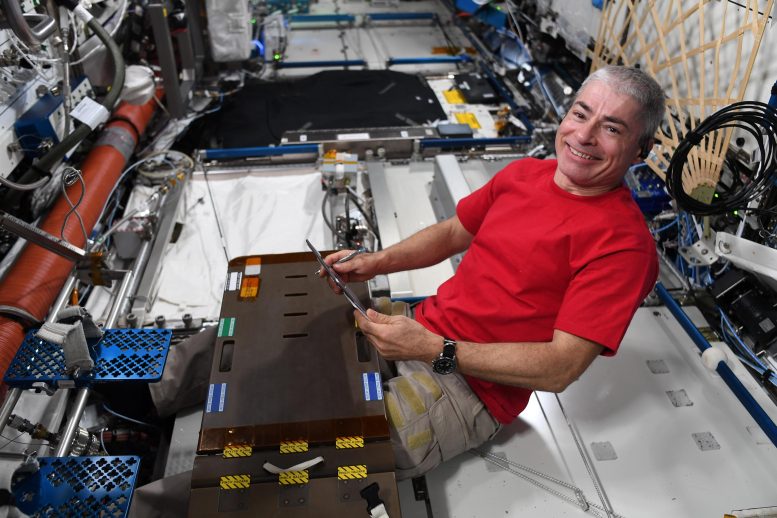
Aboard the International Space Station, NASA astronaut Mark Vande Hei squeezes in time to unwind with a book. Vande Hei made it into record books on Tuesday, March 15, 2022, breaking the record for the most consecutive days in space by an American explorer. Credit: NASA/ESA/T. Pesquet
Vande Hei made it into record books on Tuesday, March 15, 2022: He broke the record for the most consecutive days in space by an American explorer.
Vande Hei arrived at the space station on April 9, 2021, and is expected to return home on March 30, 2022, after spending 355 days in low-Earth orbit. This duration breaks the previous record, held by NASA astronaut Scott Kelly, by 15 days.
His then-crewmate Thomas Pesquet, who snapped the picture, said: “If you are reading this sitting down, maybe on a sofa or couch, consider that we will not sit down… until we are back on Earth! Of course, we don’t need to sit down up here, and I am not complaining at all, but sometimes that wonderful feeling of relaxation – that moment when you change from running around to letting yourself drop into a chair – that moment can be wonderful I am sure you all agree, and we do miss it sometimes! I think Mark did here too and made a makeshift reading table to enjoy a book – absolutely unnecessary in weightlessness but so nice to construct some semblances of normal life every now and again!”
Record-Breaking NASA Astronaut Mark Vande Hei’s Contributions to Human Research Studies
NASA astronaut Mark Vande Hei arrived at the International Space Station on April 9, 2021, and is expected to return home on March 30, 2022, after spending 355 days in low-Earth orbit. This duration breaks the previous record, held by retired NASA astronaut Scott Kelly, by 15 days.
Vande Hei will return in a Soyuz spacecraft as scheduled alongside cosmonauts Pyotr Dubrov and Anton Shkaplerov.
While clocking the single longest spaceflight by a NASA astronaut, Vande Hei contributed to dozens of studies from the hundreds executed during his mission, including six science investigations supported by NASA’s Human Research Program, or HRP.
“Our astronauts are incredible explorers helping expand our knowledge of how humans can live and work in space for longer periods of time,” said NASA Administrator Bill Nelson. “Mark’s record-setting mission and his contributions to science are paving the way for more people to travel to space on longer duration missions as the agency pushes the boundaries of exploration to the Moon and Mars. Thank you for your service, Mark, and congratulations!”
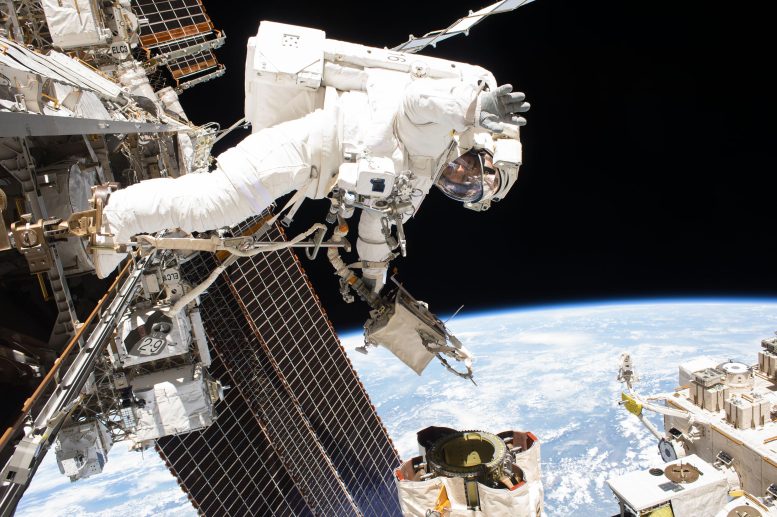
NASA astronaut and Expedition 53 Flight Engineer Mark Vande Hei is pictured during a spacewalk to service components on the Canadarm2 robotic arm during a spacewalk with NASA astronaut Randy Bresnik (out of frame). (October 10, 2017) Credit: NASA
For one investigation, Vande Hei helped grow and evaluate vegetables harvested with the space station’s Vegetable Production System, or Veggie. The investigation seeks to develop a food production system that can help astronauts meet their dietary needs with fresh vegetables cultivated in space.
Vande Hei also provided biological samples for an investigation that collects a core set of measurements, called Spaceflight Standard Measures. The investigation seeks to characterize “normal” changes in the human body during spaceflight. For instance, wrist-worn sensors that measure activity levels and light exposure can help researchers better understand the sleep-wake cycle of astronauts. Blood and saliva samples collected by crew members throughout their mission can also help scientists assess changes in various hormones, proteins, and cells that reveal how the immune system changes in space.
In addition, he contributed to a separate investigation collecting biological samples from the crew aboard the space station and placing them in a storage bank. Researchers can draw upon the samples to study spaceflight-induced changes in human physiology.
Vande Hei also participated in the first formal investigation into how eating repetitive meals in spaceflight changes the appeal of certain foods over time. In space, menu fatigue can have serious consequences, including lost appetites, nutritional deficiencies, and loss of body mass. Results will help researchers improve the design of current and future space food systems.
He is also the first astronaut on an extended mission to help researchers investigate whether an enhanced spaceflight diet can allow humans to better adapt to space. Scientists seek answers to questions such as: Could a diet packed with foods rich in nutrients such as flavonoids, lycopene, and omega-3 fatty acids boost immunity and gut microbe function on long journeys into space?
After he lands, Vande Hei will provide additional feedback to researchers investigating potential injuries such as bruises incurred by astronauts from the force of landing. This feedback will help scientists better understand whether long-term human spaceflight makes crew members more susceptible to such injuries. Results will also help NASA design protective measures in future spacecraft.
Vande Hei’s contributions will expand NASA’s knowledge about how the human body adapts to long-term spaceflight as the agency plans for future missions to the Moon and Mars. Until then, taking time to relax and read will help him balance out the rigors of space travel.
NASA’s Human Research Program, or HRP, pursues the best methods and technologies to support safe, productive human space travel. Through science conducted in laboratories, ground-based analogs, and the International Space Station, HRP scrutinizes how spaceflight affects human bodies and behaviors. Such research drives HRP’s quest to innovate ways that keep astronauts healthy and mission-ready as space travel expands to the Moon, Mars, and beyond.



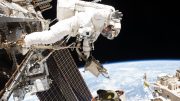
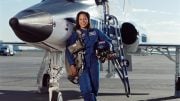
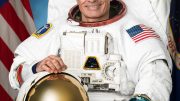
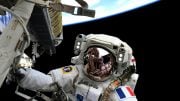
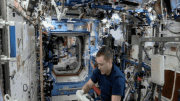
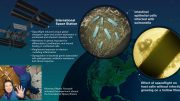
An American coming back on a Russian spacecraft in this current time of war in Ukraine.
Babu G. Ranganathan*
(B.A. Bible/Biology)
JUST BECAUSE SCIENCE CAN EXPLAIN how an airplane works doesn’t mean that no one designed or made the airplane. And just because science can explain how life or the universe works doesn’t mean there was no Designer and Maker behind them.
Natural laws may explain how the order in the universe works and operates, but mere undirected natural laws cannot explain the origin of that order. Once you have a complete and living cell then the genetic code and biological machinery exist to direct the formation of more cells from raw materials such as amino acids and other chemicals, but how could life or the cell have naturally originated when no directing code and mechanisms existed in nature? Read my Internet article: HOW FORENSIC SCIENCE REFUTES ATHEISM.
WHAT IS SCIENCE? Science simply is knowledge based on observation. No human observed the universe coming by chance or by design, by creation or by evolution. These are positions of faith. The issue is which faith the scientific evidence best supports.
SCIENCE SHOWS THAT THE UNIVERSE CANNOT BE ETERNAL because it could not have sustained itself eternally due to the law of entropy (increasing and irreversible net energy decay, even in an open system). Even a hypothetical oscillating universe could not continue to oscillate eternally! Einstein’s General Theory of Relativity shows that space, matter, and time all are physical and all had a beginning. Space even produces particles because it’s actually something, not nothing. What about the Higgs boson (the so-called “God Particle”)? The Higgs boson, even if it existed, would not have created mass from nothing, but rather it would have converted energy into mass. Einstein showed that all matter is some form of energy. Even time had a beginning! Time is not eternal.
The law of entropy doesn’t allow the universe to be eternal. If the universe were eternal, everything, including time and space (which modern science has shown are as physical as mass or matter), would have become totally entropied by now and the entire universe would have ended in a uniform heat death a long, long time ago. The fact that this hasn’t happened already is powerful evidence for a beginning to the universe.
Popular atheistic scientist Stephen Hawking admits that the universe had a beginning and came from nothing but he believes that nothing became something by a natural process yet to be discovered. That’s not rational thinking at all, and it also would be making the effect greater than its cause to say that nothing created something. The beginning had to be of supernatural origin because science teaches us from the First Law of Thermodynamics that natural laws and processes do not have the ability to bring something into existence from nothing.
The supernatural origin of the universe cannot be proved by science but science points to a supernatural intelligence and power for the origin and order of the universe. Where did God come from? Obviously, unlike the universe, God’s nature doesn’t require a beginning.
The disorder in the universe can be explained because of chance and random processes, but the order can be explained only because of intelligence and design.
Gravity may explain how the order found in the precise and orderly courses of thousands of billions of stars is maintained, but gravity cannot explain the origin of that order.
Some evolutionary astronomers believe that trillions of stars crashed into each other leaving surviving stars to find precise orderly orbits in space. Not only is this irrational, but if there was such a mass collision of stars then there would be a super mass residue of gas clouds in space to support this hypothesis. The present level of residue of gas clouds in space doesn’t support the magnitude of star deaths required for such a hypothesis. And, as already stated, the origin of stars cannot be explained by the Big Bang because of the reasons mentioned above. It’s one thing to say that stars may decay and die into random gas clouds, but it is totally different to say that gas clouds form into stars.
Even the father of Chaos theory admitted that the “mechanisms” existing in the non-living world allow for only very rudimentary levels of order to arise spontaneously (by chance), but not the kind or level of order we find in the structures of DNA, RNA, and proteins. Yes, individual amino acids have been shown to come into existence by chance but not protein molecules which require that the various amino acids be in a precise sequence just like the letters found in a sentence.
Some things don’t need experiment or scientific proof. In law there is a dictum called prima facie evidence. It means “evidence that speaks for itself.”
An example of a true prima facie would be if you discovered an elaborate sand castle on the beach. You don’t have to experiment to know that it came by design and not by the chance forces of wind and water.
If you discovered a romantic letter or message written in the sand, you don’t have to experiment to know that it was by design and not because a stick randomly carried by wind put it there. You naturally assume that an intelligent and rational being was responsible.
It’s interesting that Carl Sagan would have acknowledged sequential radio signals in space as evidence of intelligent life sending them, but he wouldn’t acknowledge the sequential structure of molecules in DNA (the genetic code) as evidence of an intelligent Cause. Read my popular Internet article, HOW DID MY DNA MAKE ME.
I encourage all to read my popular Internet articles:
NATURAL LIMITS TO EVOLUTION
HOW FORENSIC SCIENCE REFUTES ATHEISM
Visit my latest Internet site: THE SCIENCE SUPPORTING CREATION (This site answers many arguments, both old and new, that have been used by evolutionists to support their theory)
Author of popular Internet article, TRADITIONAL DOCTRINE OF HELL EVOLVED FROM GREEK ROOTS
*I have given successful lectures (with question and answer period afterwards) defending creation before evolutionist science faculty and students at various colleges and universities. I’ve been privileged to be recognized in the 24th edition of Marquis “Who’s Who in The East” for my writings on religion and science.